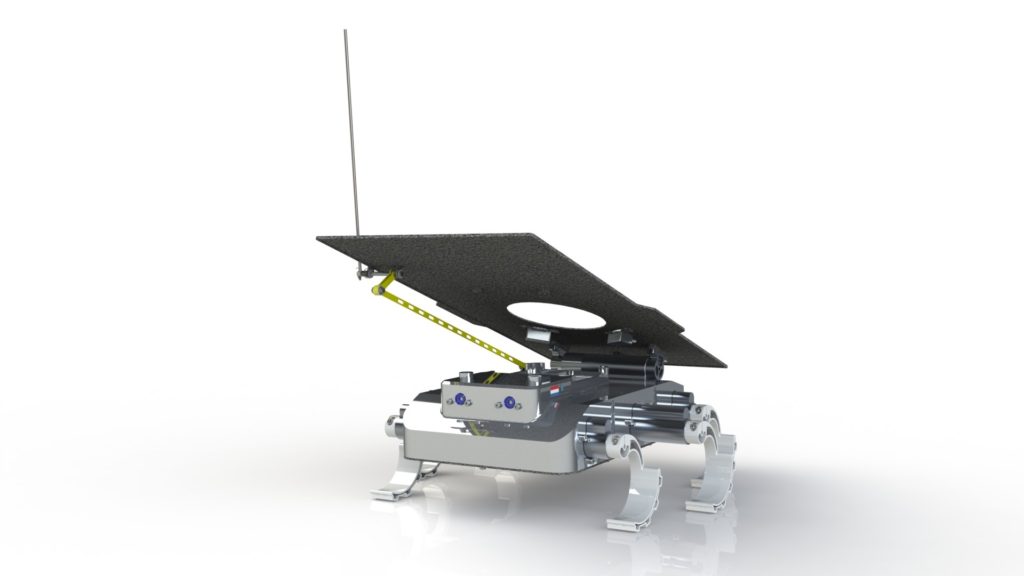The lunar mission
The main goal of the Lunar Zebro moon rover is to bring the first student-built rover to the Moon. It will demonstrate a novel locomotion technique, which should make traversing the Moon’s rough terrain more reliable and easier compared to the traditional wheels used in previous missions. The rover will travel on the lunar surface using 6 C-shaped legs while autonomously detecting obstacles, navigating through the terrain and communicating with the ground station directly. Once these tasks are performed successfully, it will be possible to further improve the rover’s adaptability and capability on the rough terrain and harsh environments of other planetary destinations.
Student project
Besides the peculiar goal of sending the smallest and lightest rover ever built to the Moon, the uniqueness of the Lunar Zebro mission also comes from the hands on experience it offers to students. The entire development and operation of the rover and its mission is run by students of TU Delft,InHolland and Haagse Hogeschool.The student team is currently working on designing and manufacturing a development model of the rover. This model will go through several tests and serves as an intermediate phase to the qualification model, which will be used to validate various new components and measure their performance under determined space conditions. Eventually, the flight model will piggyback on a moon lander to reach the Moon, its final destination. If everything goes according to plan, future missions will consist of multiple Lunar Zebro rovers, which exhibits the possibility of implementing swarming technology for exploration and commercial purposes. The technology would not only be useful in space, but also right here on Earth, in scenarios like the search for trapped people after a natural disaster or the deployment of sensors in remote locations to collect data for more accurate predictions and ground truth.
Support and collaboration
TU Delft Space Institute (DSI) has been part of Lunar Zebro since the beginning of the project and is one of its founding partners, alongside the TU Delft Robotics Institute. The DSI plays a major role in the project’s day to day activities and its long term plan to send a swarm of lunar rovers to the Earth’s natural satellite.
One of the most important contributions of DSI to the project has been the availability of experienced staff members as part of the team. Critical subsystems like communications and a power distribution unit have been developed by or under direct supervision of these experts. DSI also provides the project with the ability to do small scale verification and validation of the thermal simulations of a number of our subsystems. Furthermore, DSI contributes one of the payloads for the mission – a sensor, which will measure the radiation levels on the lunar surface on the landing site.
Lunar Zebro is also constantly able to receive and share information with the engineers working on DSI’s latest Delfi-PQ satellite mission. This insures that both projects will reach their mission objectives more efficiently, since they have quite a lot of technical and operational aspects in common.
For any further inquiries, contact Lead Public Relations: media.spacezebro@tudelft.nl
Lunar Zebro IGLUNA 2021
Coordinated by the Space Innovation, the ESA_Lab@CH project IGLUNA 2021 offered the opportunity to student teams to participate in an international, collaborative project. The mission covered six research topics: life support systems, habitat conception and structure, communication and navigation, power management, human well-being and science. The Field Campaign took place in Lucerne at the VERKEHRSHAUS – Swiss Museum of Transport and on top of Mount Pilatus in July 2021.
Along with 13 other university teams from 9 different countries, Lunar Zebro took part in this mission as well. The overall goal of the Lunar Zebro project at IGLUNA was to design, plan and build a swarm-like group of self-deploying, fault tolerant, inexpensive, and miniaturized robots, which roam autonomously within the pre-determined perimeter.
The cold temperatures and harsh environment make mount Pilatus a perfect location for recreating the Lunar environment. It provided the project with a unique opportunity to take the first step towards implementing swarming in such a habitat, as well as to test and validate some of the Lunar Zebro’s crucial subsystems.
